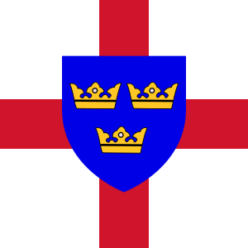I started the new year by going on coastal walk from Great Yarmouth to Southwold with a stay in Lowestoft. This was partly inspired by W. G. Sebald’s famous The Rings of Saturn, in which the narrator follows the Suffolk Coast Path. In a film based on the book, Robert MacFarlane says that one should not walk this route merely because one likes Sebald, but luckily this did not apply to me since I am of course interested in walking through East Anglia anyway.
Sebald starts in Somerleyton, home of the inventor of the hovercraft. I didn’t want to wait to see the seaside though, and so decided to begin my walk in Great Yarmouth and hence in Norfolk. In order to get the most out of the daylight I took an early train from Cambridge, but unfortunately missed the connecting train in Norwich by one minute and had to wait there for a whole hour. This proved to be a benefit rather than a nuisance however, since the next train to Yarmouth ended up being loco-hauled by class 37s:

These and their memorable sound already made an appearance in the post about the walk to Great Yarmouth; but I had never actually used this kind of train before and was hence very pleased.
After arriving in Yarmouth I walked along a road south towards Gorleston-on-Sea. The weather was quite pleasant, and I soon reached the end of Yarmouth and the beginning of Gorleston:

I walked along the promenade, at the end of which I joined the Norfolk Coastal Path.

Pretty soon the path disappeared, however, because the cliffs and dunes along the beach have been eaten up by erosion. I thus had to continue walking along the beach, on which one can find debris of fences that used to stand at the edge of the cliffs:

At some point it was possible to leave the beach and continue on top of the cliffs, from where the view was much better. There was no shortage of uninviting notices, however: The concrete promenade along the beach is no longer accessible, and soon the cliff path itself ended with an assortment of warning signs:


While in Norfolk the coastal path is signposted well, but after I had crossed the border to Suffolk no more sign were to be seen. According to my map the footpath did nevertheless continue all the way to Lowestoft, but I had some trouble locating it in the real world, and ended up in a muddy field next to a rifle range.


Eventually I arrived at the edge of a Caravan park. There was a path along the cliffs which I assumed would be the public footpath, however strangely enough it was fenced off from all sides and could not be used. Since there was no other way out I had to walk through the caravan park instead, staying as far away from the caravans as possible. After that I went through some more fields until I reached the village of Corton, where for the first time since entering Suffolk there was a public footpath sign. Unfortunately, however, what this sign said was that the footpath along the coast had been lost due to coastal erosion.
Subsequent investigations showed that the clifftop path I had seen on my map was destroyed in the winter of 2012. (Unlike other counties, Suffolk doesn’t seem to have a list of closed and diverted footpaths online, so it was difficult to predict these complications). One can thus not recommend walking the route I had taken, because the way through the caravan park is on private land. This is very unfortunate, since as far as I had been able to make out is is also not possible to walk this stretch on the beach either.
After passing through Corton Lowestoft was now close. I had never been there before and was very curious, since it is Britain’s most easterly town and home to the easternmost point of the country. As usual for the seaside, the border between town and country was marked by caravans:

This is what Ness Point – Britain’s easternmost point – looks like:

It must be admitted that it is probably not the most spectacular extreme point, a view which is also reflected in a number of harsh reviews of the location on Google Maps. The reason for this is presumably that Ness Point is located in quite an industrial part of Lowestoft, as is indicated by the rather prosaic street names nearby:

I was pleased to find that Lowestoft has more scenic parts as well, especially the promenade south of the river. Here there are rows and rows of traditional British hotels and bed and breakfasts, in one of which I stayed the night – as the only guest, in fact, since January is not exactly high season.

My stay there was very pleasant, and the next day I was ready to continue my coastal walk to Southwold, which will be the topic of the second part.

